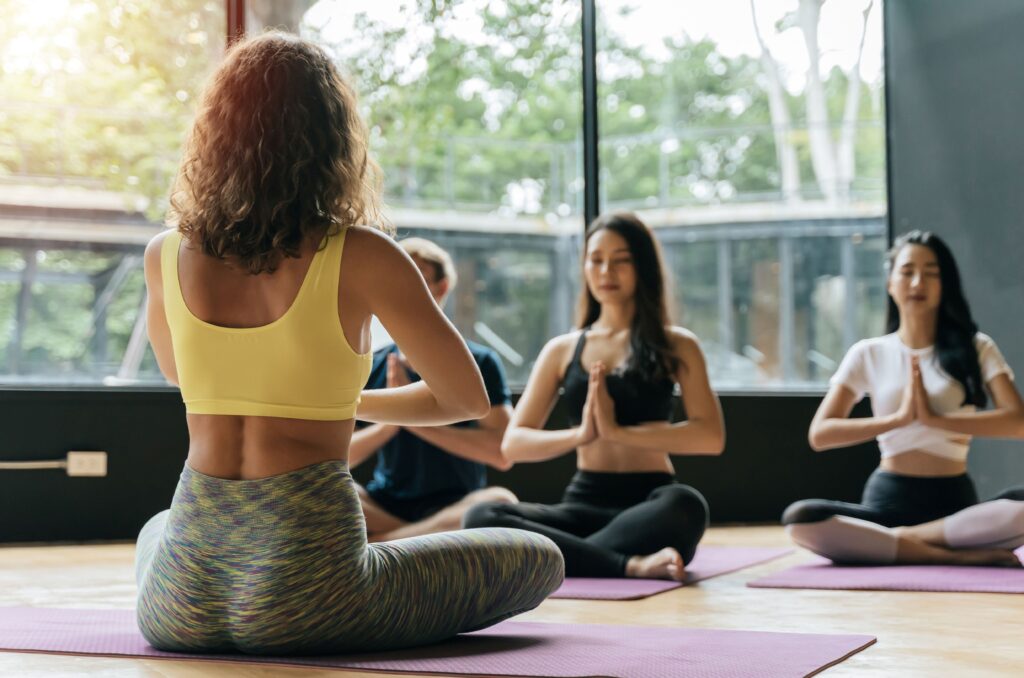Public speaking can feel downright terrifying, can’t it? The shaky voice, the sweaty palms, that heart-pounding moment of panic – we’ve all been there. But here’s the good news: there’s a surprisingly simple way to tackle those nerves head-on and it’s something you might already be doing – exercise!
Yes, that same workout that gets your heart pumping and your endorphins flowing can also be a game-changer for your confidence on stage. From calming pre-speech jitters to boosting mental clarity, exercise isn’t just great for your body – it’s your secret weapon against public speaking anxiety.
In this post, we’ll explore how different types of exercise can help you feel grounded, focused, and ready to shine. Plus, I’ll share three easy strategies to turn every workout into a confidence-building tool for your next big presentation.
Sound exciting? Let’s dive in!
The Link Between Exercise and Public Speaking Anxiety
Exercise has a significant impact on your mental health.
Physical activity increases the production of mood-boosting chemicals like serotonin, endorphins, and dopamine, which help reduce stress and promote relaxation – two things every speaker needs before stepping on stage.
Regular workouts also regulate your body’s stress response, easing the physical symptoms of anxiety that often show up when preparing to speak: a racing heart, sweaty palms, or shortness of breath.
Over time, exercise strengthens your ability to handle stress, helping you feel calmer, more in control, and better equipped to deliver your message with confidence.
My Journey: How Fitness Helped my Public Speaking
I’ve always loved staying active. Ever since I was a kid, I used to try out different sports and activities. These days, you’ll find me doing everything from jogging and yoga to pole dancing and kick boxing. While exercise started as a way to stay fit and have fun, I discovered it offered so much more.
The connection between fitness and public speaking clicked for me when I realized how these activities helped me feel calmer, more focused, and in control. Whether it was learning to steady my breath or finding strength through challenges, exercise became my secret weapon for managing nerves and boosting confidence.
This is why I am so excited to share this post with you. I know firsthand how empowering exercise can be for managing public speaking anxiety. Whether you’re new to fitness or already have a workout routine, this post will show you how to harness movement to feel more confident, grounded, and prepared every time you speak.
Best Exercises for Managing Anxiety
Different types of exercise help you prepare for public speaking in unique ways, from boosting your mood to steadying your breath.
Here are some of the most effective forms of exercise to help manage anxiety and prepare you for public speaking:
1. Aerobic Exercise (Cardio)
Aerobic exercise, like running, cycling, swimming, or dancing, is a powerful way to manage anxiety. It boosts cardiovascular health, releases mood-enhancing endorphins, reduces muscle tension, and lowers stress-causing cortisol levels. Plus, it improves oxygen flow throughout your body, sharpening mental clarity.
Why It Helps with Public Speaking Anxiety:
Aerobic workouts train your body to handle a racing heart and stress more efficiently, making you feel calmer and more in control. Better circulation also means more oxygen to your brain, helping you stay focused and sharp when it’s time to speak.

2. Yoga & Pilates
Yoga and Pilates are excellent for managing anxiety, focusing on the mind-body connection through controlled breathing, flexibility, and core strength. These low-impact exercises are ideal for calming nerves before a big speaking event.
Why They Help with Public Speaking Anxiety:
Shallow, rapid breathing is a common challenge when nerves kick in. Yoga and Pilates teach deep, controlled breathing that activates your body’s “calm down” mode, reducing anxiety symptoms like trembling or shortness of breath. This lets you stay composed and deliver your message confidently.
3. Strength Training
Strength training isn’t just about building physical strength – it’s a powerful confidence booster. Exercises like squats, lunges, and push-ups help you develop a sense of mastery over your body, building both mental strength and self-assurance over time.
Why It Helps with Public Speaking Anxiety:
Confidence is key for public speaking, and strength training fosters it by enhancing your sense of accomplishment and body awareness. Improved posture from strength workouts not only boosts your presence but also reduces anxiety by signaling to your brain that you’re in control and ready to handle stress.
4. High-Intensity Interval Training (HIIT)
HIIT workouts involve short bursts of intense activity followed by rest, mimicking the stress-adrenaline cycle. This training helps your body adapt to adrenaline surges, much like those experienced before public speaking.
Why It Helps with Public Speaking Anxiety:
Public speaking triggers a “fight or flight” response, with symptoms like sweaty palms and a racing heart. HIIT trains you to handle these stress spikes and recover quickly, building resilience over time. As a result, you’ll feel more composed and in control when it’s time to take the stage.
5. Team Sports and Group Activities
Team sports and group activities like basketball, volleyball, or group hikes offer unique benefits for reducing anxiety. Beyond exercise, they help build communication, leadership, and teamwork skills in a fun, supportive environment.
Why They Help with Public Speaking Anxiety:
Public speaking is social, and team sports strengthen interpersonal skills while reducing isolation. They also provide low-pressure opportunities to practice speaking in front of others, whether leading a warm-up or chatting with teammates. These experiences build confidence and ease in communication, preparing you for larger audiences.
3 Strategies to Make the Most of Your Exercise
Now that we’ve explored the best types of exercises to combat public speaking anxiety, let’s dive into how to maximize their benefits.
The key is intentional practice—using your workouts to target specific outcomes like breath control, heart rate regulation, and mental calmness. Here’s how to do it:
1. Focus on Your Breathing
Breathing is a game-changer when it comes to managing anxiety, especially for public speaking. Exercise is the perfect time to practice because it mimics the physiological effects of anxiety, like a racing heart or shortness of breath.
How to Use This Strategy:
- Cardio: During a walk or run, focus on breathing in through your nose and out through your mouth. If your mind wanders, gently bring your attention back to your breath—it’s like moving meditation.
- Yoga and Pilates: These practices naturally teach breath control. Sync your breathing with your movements to feel more present and grounded.
- HIIT: Pay attention to your breathing during intense bursts and use the rest periods to practice calming your breath. This helps you recover quickly, a skill you can use to steady yourself before speaking.
Practicing breath control in your workouts can help you stay focused, manage nerves, and even enhance your delivery with well-timed pauses. For more on using breath to manage anxiety, check out my blog post on breathing techniques.

2. Focus on Progress
Whether in fitness or public speaking, progress doesn’t happen overnight. But tracking small wins can keep you motivated and build resilience.
How to Use This Strategy:
- Track your fitness progress – whether it’s running farther, lifting heavier weights, or holding a yoga pose longer. Celebrate those small victories.
- Apply this mindset to public speaking – Did you use fewer filler words? Make better eye contact? Manage your nerves a little better? Take note and give yourself credit.
Recognizing progress in your workouts builds the mental toughness that translates to public speaking. Small wins lead to big gains.
3. Focus on Getting Social and Being a Leader
Team sports and group activities offer unique opportunities to develop your communication and leadership skills in a low-pressure environment.
How to Use This Strategy:
- Take on leadership roles, like being a team captain or organizing group events. It’s a safe way to practice guiding others and improving your communication skills.
- Use the group setting to test public speaking techniques. Practice storytelling, offer encouragement, or resolve conflicts.
- Pay attention to how teamwork and camaraderie reduce stress, and apply those principles to public speaking situations.
By engaging with others in a supportive setting, you’ll build social confidence that carries over to the stage.
Incorporating These Strategies Into Your Daily Life
To make these strategies a regular part of your routine, try these tips:
- Start Small: Begin with a 10-minute mindful walk or a simple stretch session. Build momentum gradually.
- Mix It Up: Alternate between calming yoga, energizing cardio, and adrenaline-pumping HIIT to keep workouts engaging.
- Set Realistic Goals: Focus on incremental progress, like steadying your breath or staying present during a speech.
- Stay Consistent: Results take time, so stick with your routine to see meaningful improvements.
- Have Fun: Choose activities you enjoy – it’s easier to stay consistent when exercise feels like play, not another task on your to-do list.
It’s All About Taking The First Step
Exercise isn’t just a tool to reshape your body; it’s a way to boost confidence and tackle public speaking anxiety.
By incorporating these strategies into your fitness routine, you’ll learn to control your breathing, build mental strength, and enjoy the journey.
Remember, it’s not about perfection – it’s about progress. Every step forward, no matter how small, is a win.
Ready to take that first step? Try these strategies and share your experience in the comments below. I’d love to hear how they’ve helped you!

